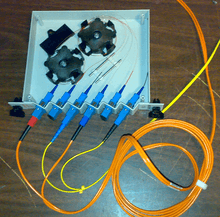Fiber tapping
Fiber tapping uses a network tap method that extracts signal from an optical fiber without breaking the connection. Tapping of optical fiber allows diverting some of the signal being transmitted in the core of the fiber into another fiber or a detector. Fiber to the home (FTTH) systems use beam splitters to allow many users to share one backbone fiber connecting to a central office, cutting the cost of each connection to the home. Test equipment can simply put a bend in the fiber and extract sufficient light to identify a fiber or determine if a signal is present.

Similar techniques can surreptitiously tap fiber for surveillance, although this is rarely done where electronic equipment used in telecommunication is required to allow access to any phone line for tapping by legal authorization. Tapping the fiber means that all signals from every communications source being routed through the fiber are presented and must be sorted for relevant data, an immense task when thousands of sources of data or voice may be present.
According to reports, the US government used fiber tapping for surveillance following the September 11, 2001 attacks, and a nuclear submarine, the USS Jimmy Carter, was modified to allow tapping undersea cables.[1]
Detecting fiber taps
One way to detect fiber tapping is by noting increased attenuation added at the point of tapping. Some systems can detect sudden attenuation on a fiber link and will automatically raise an alarm.[2] There are, however, tappers which allow tapping without significant added attenuation.
In either case there should be a change of scattering pattern in that point in line which, potentially, can be detectable. However, once the tapper has been detected it may be too late since a part of the information has been already eavesdropped on.[3]
Countermeasures
One countermeasure is encryption, to make the stolen data unintelligible to the thief.[4] Another is to deploy a fiber-optic sensor into the existing raceway, conduit or armored cable. In this scenario, anyone attempting to physically access the data (copper or fiber infrastructure) is detected. A small number of alarm systems manufacturers provide a simple way to monitor the optical fiber for physical intrusion. There is also a proven solution that utilizes existing unused fiber (dark fiber) in a multi-strand cable for the purpose of creating an alarm system.
In the alarmed cable scenario, the sensing mechanism uses optical interferometry in which modally dispersive coherent light traveling through the multi-mode fiber mixes at the fiber's terminus, resulting in a characteristic pattern of light and dark splotches called a speckle pattern. The laser speckle is stable as long as the fiber remains immobile, but flickers when the fiber is vibrated. A fiber-optic sensor works by measuring the time dependence of this speckle pattern and applying digital signal processing to the fast Fourier transform (FFT) of the temporal data.
The U.S. government has been concerned about the tapping threat for many years. In the context of classified information on United States Department of Defense (DOD) networks, protective distribution system (PDS) is a set of military instructions and guidelines for network physical protection. PDS is defined as a system of carriers (e.g. raceways, conduits, or ducts) used to distribute military and national security information between two or more controlled areas, or from a controlled area through an area of lesser classification, i.e., outside the Sensitive Compartmented Information Facility (SCIF) or other similar area. PDS provides guidance for the protection of SIPRNet wire line and optical fiber to transmit unencrypted classified information.
See also
- NSA fiber-optic tapping
References
- "Jimmy Carter: Super Spy?". Military.com. Military Advantage. 21 February 2005.
- "Allied Telesis Introduces Innovation in Fiber Security to Prevent Eavesdropping". alliedtelesis.com. San Jose, CA: Allied Telesis. 20 January 2016. Archived from the original on 23 January 2016.
- Technical Information Bulletin 00-7: All-Optical Networks. NCS Technical Information Bulletin. National Communications System. August 2000 – via Homeland Security Digital Library.
- "Blueprint: Metro Ethernet". Archived from the original on 2007-09-27. Retrieved 2007-02-15.